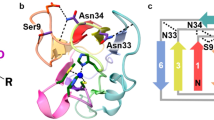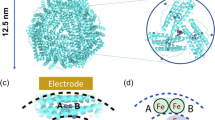Abstract
RECENTLY, Gillard, McKenzie, Mason, Mayhew, Peel and Stangroom1 presented optical rotatory dispersion data on non-haem iron proteins from several sources. They found that whereas the bacterial ferredoxins from Clostridium acidi-urici, C. pasteurianum and Peptostreptococcus elsdenii and the rubredoxin from P. elsdenii have very similar optical rotatory dispersion spectra in both the oxidized and reduced forms, these spectra differ qualitatively from that obtained with oxidized plant (parsley and spinach) ferredoxin. No data were presented on reduced plant ferredoxin, and indeed it has been reported2 that reduced plant ferredoxin has no optical activity in the visible region of the spectrum. Gillard et al. consequently suggested “that the bonding of iron in plant ferredoxin is entirely different from that in bacterial ferredoxin and rubredoxin”.
This is a preview of subscription content, access via your institution
Access options
Subscribe to this journal
Receive 51 print issues and online access
$199.00 per year
only $3.90 per issue
Buy this article
- Purchase on Springer Link
- Instant access to full article PDF
Prices may be subject to local taxes which are calculated during checkout
Similar content being viewed by others
References
Gillard, R. D., McKenzie, E. D., Mason, R., Mayhew, S. G., Peel, J. T., and Stangroom, J. E., Nature, 208, 769 (1965).
Handler, P., Rajargopalan, K. V., and Aleman, F., quoted by Vallee, B. L., and Ulmer, D. D., in A Symposium on Non-heme Iron Proteins, edit. by San Pietro, A., 43 (Antioch Press, Yellow Springs, 1965).
Palmer, G., and Brintzinger, H. (in preparation).
Ulmer, D. D., and Vallee, B. L., Biochemistry, 2, 1335 (1963).
Palmer, G., and Sands, R. H., J. Biol. Chem., 261, 253 (1966).
Palmer, G., Sands, R. H., and Mortensen, L. E., Biochem. Biophys. Res. Commun. (in the press).
Palmer, G., Sands, R. H., and Mortensen, L. E. (unpublished results).
Mower, H. F., and Piette, R. (personal communication).
Tagawa, K., and Arnon, D. I., Nature, 195, 537 (1962).
Levenberg, W. B., Buchanan, B. B., and Rabinowitz, J. C., J. Biol. Chem., 238, 3899 (1963).
Levenberg, W., and Sobel, B. E., Proc. U.S. Nat. Acad. Sci., 54, 193 (1965).
Wickman, H. H., Klein, M. P., and Shirley, D. A., J. Chem. Phys., 42, 2113 (1965).
Clark, J. R., and Feeney, R. E., Biochemistry, 2, 1341 (1963).
Brintzinger, H., Palmer, G., and Sands, R. H., Proc. U.S. Nat. Acad. Sci., 55, 397 (1966).
Arnon, D. I., in A Symposium on Non-heme Iron Proteins, edit. by San Pietro, A., 137 (Antioch Press, Yellow Springs, 1965).
Author information
Authors and Affiliations
Rights and permissions
About this article
Cite this article
PALMER, G., BRINTZINGER, H. Nature of the Non-haem Iron in Ferredoxin and Rubredoxin. Nature 211, 189–190 (1966). https://doi.org/10.1038/211189a0
Issue Date:
DOI: https://doi.org/10.1038/211189a0
This article is cited by
-
Cotton Effects in Plant Ferredoxin and Xanthine Oxidase
Nature (1967)
Comments
By submitting a comment you agree to abide by our Terms and Community Guidelines. If you find something abusive or that does not comply with our terms or guidelines please flag it as inappropriate.



